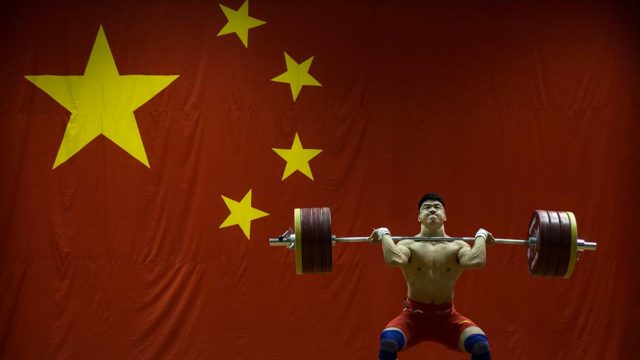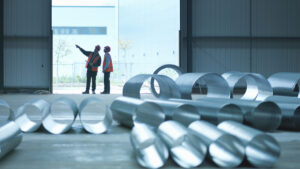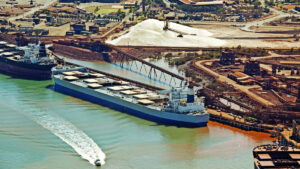Back before the last mining boom buying a tonne of iron ore was little more than a trip to the corner store, with the bulk commodity fetching prices in the range of US$30/t.
When Chinese steel production and industrial growth began to overtake the rest of the world, a price model characterised by inflexible annual contractual arrangements became untenable.
The solution was the more transparent pricing system set up in 2010, where contract prices were linked to daily spot prices published by price reporting agencies like Platts and Metal Bulletin (now Fastmarkets MB).
Is that still serving its purpose? No says the Chinese Communist Party, which saw its companies chuck around $150 billion Australia’s way for iron ore in 2021.
Seeing prices run up from US$87/t in November to more than US$150/t a couple weeks ago, the CCP has moved back into price suppression mode, blaming “speculation” for sending prices higher.
Its latest gambit, as Bloomberg reports, is a centralised buying platform for iron ore sales into China, around 60% of which come from Australian majors like BHP (ASX:BHP), Rio Tinto (ASX:RIO) and Fortescue (ASX:FMG).
Some analysts have been sceptical that China’s attempts to talk down iron ore prices will have long term success.
Morgan Stanley last week said it still sees prices climbing to an eye-watering US$175/t in the second quarter, while even bearish analysts are upping forecasts, such as Fitch, which increased its 2022 estimate from US$90/t to US$120/t this week.
Could the most radical proposed change to iron ore pricing in over 10 years have bigger impacts?
China trying to increase its market power
China’s inability to control prices in recent years has, on its face, largely been due to the soaring demand from within its walls for steel.
Steel production hit a record 1.065Bt in 2020, a rapid acceleration even from the 870.9Mt produced in 2017 when China’s output eclipsed the rest of the world’s combined.
In 2021 prices hit a record high of US$237/t in May as massive steel mill margins drove the country’s producers to produce at an annualised rate of almost 1.2Bt through the first half of the year.
Environmental restrictions chilled that, but it has been a hot market that has certainly favoured the large scale, low cost Pilbara majors to sell into and generate record profits in recent years.
China, which is engulfed in a tense diplomatic dispute with Australia that has seen it levy $20 billion of import bans on everything from coal to wine, is a little concerned about how much dosh it’s sending our way.
RBC Capital Markets analyst Tyler Broda said the proposal for a centralised sales platform could tip the market balance in China’s favour, especially if steel production in the Middle Kingdom begins to decline in the coming years.
“The implications from this move could be wide-ranging and material,” he said.
“There is a fervent debate at the moment on the short-term iron ore outlook, but on a wider basis, it is generally a consensus expectation that Chinese steel consumption has/will peak over the next few years.
“This slower rate of growth potentially allows China to manage its external demand for iron ore in a more cohesive centralised manner.
“There is no information on what this structure would entail, whether it would move back to long-term negotiations or have just one giant buyer effectively setting the price in the spot market.”
Broda believes centralisation would reduce the efficiencies of a market driven system, but could also limit volatility.
However, he says it could tip market power in China’s favour.
“In our view, centralisation and coordination would likely transfer value at the margin to China apart from when the market was in a material deficit (which we don’t forecast out through 2026),” he said.
“As well as providing more control on input cost inflation, China would be able to better control input prices for its high-employment steel industry, allowing it to better manage slower growth from the investment side of the economy, something which is likely to occur over the coming decade as consumption as a share of growth increases in line with policy goals.”
Centralised sales could favour other ores
China’s NDRC has issued calls also to increase its self sufficiency in the steel supply chain in recent months.
Its previously discussed methods have been boosting domestic iron ore production, increasing scrap steel consumption (something likely only to grow at a slow pace) and investing in Chinese-owned mines internationally like the Simandou project in Guinea.
Having more control over prices could help it be more selective over which countries its steel mills do business with, Broda suggested.
“With political relations between China, and its largest supplier Australia frayed, this could also give China another angle from which to project political power,” he suggested.
“In 2021, China imported 693mt of iron ore from Australia or 61% of a total 1,125mt.
“With the decision to purchase ore centralised, could China favour Brazilian or South African ores benefiting producers such as VALE or Anglo American?”
At current consumption rates China needs its number one supplier, Broda noted, asking whether the news would yield a response from BHP and Rio (which reports its annual earnings today) or the Australian Government.
Details still blowin’ in the wind
What exactly will the plan entail? The answer my friend is still, as Bob Dylan would say, blowin’ in the wind.
Some market experts say more information is needed.
“I feel that the idea as it has been reported so far lacks sufficient detail to be able to say whether it is possible or realistic,” Fastmarkets senior price development manager Peter Hannah told Stockhead.
“There are too many questions around how exactly it would work to make an informed judgement.
“As a general point though, economic history shows us that open, market-oriented pricing mechanisms are the most efficient means of fairly valuing commodities and incentivising supply and demand to balance over time.”
Commbank analyst Vivek Dhar said in a note that speculation alone was not behind the run up in prices, with the CCP’s own economic growth policies such as lending rate cuts helping drive steel demand and support mill margins.
“While we tend to agree that speculation may have helped the rally in iron ore prices above $US150/t, the rise in iron ore prices was always on the cards given the easing policy bias of the People’s Bank of China (PBoC),” he said.
“Infrastructure investment will likely follow, helping steel demand hopes in coming months. Lower interest rates are also likely to stabilise the downturn in the property construction sector. These sectors each account for ~30% of China’s steel demand.”
China, Dhar says, is caught between two conflicting policies.
“On the one hand, Chinese authorities are looking to drive economic growth via policies that will support steel demand. Steel mill margins are relatively healthy as a result and providing support for iron ore prices.
“On the other hand though, policymakers are keen to limit inflation linked to higher iron ore prices. Their determination to keep iron ore prices in check is particularly strong given their belief that non‑market forces like speculation are at play.”
Given China consumes around 70-75% of all iron ore imports, Dhar believes having a centralised purchasing platform could impact prices in the medium to long term by unifying the fragmented Chinese steel market.
“Mergers and acquisitions amongst China’s large steelmakers are expected to continue,” he said.
“This should eventually see China’s influence on iron ore prices increase and ultimately challenge the pricing power held by iron ore producers (where market concentration is stronger).
“Plans to invest and develop iron ore mines outside of China, like the Simandou project in Guinea, as well as boosting scrap steel usage, should see China’s exposure to iron ore markets lessen in the longer term.”
Strong investment signals from the Chinese real estate market limited losses on futures markets following the bearish news, with Dalian iron ore futures unchanged after rallying in the morning session and Singapore Futures for March delivery down just 1.35% to US$138/t.
Spot 62% Fe content iron ore rose US$6 to US$140/t on Monday ahead of the Bloomberg article’s release after China’s four biggest banks lowered mortgage rates in Guangzhou by 20 basis points, Reuters reported.
Hawsons looks to expand magnetite project
Hawsons Iron (ASX:HIO) says it will double the proposed scale of its iron ore project of the same name in Broken Hill from 10Mtpa to 20Mtpa in an upcoming feasibility study.
Hawsons announced on Monday that it was increasing the scope of its BFS and increasing its budget for the study by $12.4m with funding from an equity facility set up with LDA Capital last year.
HIO says it will be looking into two pathways to get the proposed high grade magnetite concentrate mine to market, a 10Mtpa with rail to transport its concentrate to port or a 20Mtpa project including the construction of a slurry pipeline.
Located on the New South Wales-South Australia border, HIO executive chairman Bryan Granzien said a slurry pipeline would be needed to transport the ore to port in the 20Mtpa option because of limitations to the rail capacity it could access on the line from Broken Hill to Port Pirie.
“The scale, quality and homogeneity of the Hawsons’ orebody and the demand for high quality magnetite due to the shift to green steel enables us to consider transport options to remove that capacity constraint,” Granzien said in a statement on the release.
“A direct-to-port slurry pipeline offers Hawsons a higher level of autonomy and potentially opens up the Braemar minerals province for further development.
“The assessment process will look at port options in Eastern Spencer Gulf. Modelling and reevaluating PFS assumptions, will enable us to select the optimum scale and transport option to take Hawsons Supergrade product to market.”
Higher grade iron ore products will be essential to help steel producers reduce their emissions profiles, a shift that has seen major producers like BHP, Rio Tinto and FMG also invest in projects that will lift their average export grade.
Direct reduced iron processes, which may use green hydrogen as fuel if it proves commercially viable, require high grade iron ore to work efficiently. However, this hydrogen powered technology could still be decades away.
Higher iron ore grade blends can also help reduce emissions in the traditional blast furnace process which dominates the crude steel industry today because they require less coking coal.
ASX iron ore stocks
Scroll or swipe to reveal table. Click headings to sort.
| CODE | COMPANY | PRICE | 1 WEEK RETURN % | 1 MONTH RETURN % | 6 MONTH RETURN % | 1 YEAR RETURN % | MARKET CAP |
|---|
| ACS | Accent Resources NL | 0.056 | 0% | 4% | 8% | -51% | $ 26,097,527.85 |
| ADY | Admiralty Resources. | 0.02 | -5% | 43% | 43% | 11% | $ 26,071,583.06 |
| AKO | Akora Resources | 0.36 | 0% | 44% | 76% | -5% | $ 19,890,513.28 |
| BCK | Brockman Mining Ltd | 0.059 | -3% | 26% | 55% | 31% | $ 547,474,695.73 |
| BHP | BHP Group Limited | 47.81 | -1% | 5% | 8% | 1% | $ 244,206,470,685.60 |
| CIA | Champion Iron Ltd | 6.5 | -9% | 7% | 15% | 23% | $ 3,450,967,331.68 |
| CZR | CZR Resources Ltd | 0.008 | 0% | 0% | -11% | -33% | $ 27,890,586.22 |
| DRE | Dreadnought Resources Ltd | 0.04 | 0% | -2% | -2% | 122% | $ 116,386,025.59 |
| EFE | Eastern Resources | 0.049 | -11% | -33% | 277% | 304% | $ 55,115,724.94 |
| CUF | Cufe Ltd | 0.036 | -16% | 0% | -35% | -28% | $ 36,898,382.24 |
| FEX | Fenix Resources Ltd | 0.23 | -8% | -2% | -13% | -8% | $ 115,509,201.60 |
| FMG | Fortescue Metals Grp | 19.32 | -15% | -8% | -5% | -19% | $ 60,378,502,041.98 |
| FMS | Flinders Mines Ltd | 0.52 | 1% | 0% | -40% | -66% | $ 79,358,831.19 |
| GEN | Genmin | 0.21 | 5% | -9% | 5% | 0% | $ 62,103,327.00 |
| GRR | Grange Resources. | 0.78 | -7% | 0% | 43% | 117% | $ 920,084,264.91 |
| GWR | GWR Group Ltd | 0.1575 | -5% | -13% | -32% | -44% | $ 52,030,159.83 |
| HAV | Havilah Resources | 0.165 | -8% | -8% | -15% | -20% | $ 52,667,148.69 |
| HAW | Hawthorn Resources | 0.089 | -6% | -11% | 102% | 14% | $ 29,349,373.94 |
| HIO | Hawsons Iron Ltd | 0.16 | -16% | -26% | 70% | 307% | $ 121,559,001.50 |
| IRD | Iron Road Ltd | 0.185 | -3% | -3% | -5% | -35% | $ 147,168,992.03 |
| JNO | Juno | 0.1 | -13% | -20% | -41% | 0% | $ 14,922,380.11 |
| LCY | Legacy Iron Ore | 0.018 | 0% | -18% | 29% | -28% | $ 121,729,697.78 |
| MAG | Magmatic Resrce Ltd | 0.105 | 7% | 11% | -13% | -32% | $ 25,448,679.80 |
| MDX | Mindax Limited | 0.039 | -7% | 11% | -13% | 1200% | $ 76,197,431.00 |
| MGT | Magnetite Mines | 0.03 | -17% | -21% | -3% | 11% | $ 100,983,900.19 |
| MGU | Magnum Mining & Exp | 0.066 | -10% | -33% | -26% | -21% | $ 34,800,143.98 |
| MGX | Mount Gibson Iron | 0.555 | 0% | 29% | -20% | -37% | $ 708,182,299.31 |
| MIN | Mineral Resources. | 45.58 | -11% | -29% | -11% | 21% | $ 8,943,945,992.96 |
| MIO | Macarthur Minerals | 0.38 | 0% | 9% | -27% | -40% | $ 55,153,518.06 |
| PFE | Panteraminerals | 0.18 | -10% | -3% | -49% | 0% | $ 8,355,750.00 |
| PLG | Pearlgullironlimited | 0.075 | 15% | 7% | 0% | 0% | $ 4,392,184.64 |
| RHI | Red Hill Iron | 3.7 | 3% | 22% | 20% | 1096% | $ 229,781,336.40 |
| RIO | Rio Tinto Limited | 118.5 | -3% | 9% | 11% | -4% | $ 44,620,188,922.80 |
| RLC | Reedy Lagoon Corp. | 0.026 | -13% | -37% | 53% | -4% | $ 15,340,002.44 |
| SHH | Shree Minerals Ltd | 0.017 | -19% | 21% | 70% | 6% | $ 19,138,264.06 |
| SRK | Strike Resources | 0.105 | -16% | -19% | -40% | -48% | $ 29,700,000.00 |
| SRN | Surefire Rescs NL | 0.012 | -25% | -8% | -20% | -61% | $ 15,460,345.73 |
| TI1 | Tombador Iron | 0.033 | -13% | -20% | -34% | -63% | $ 40,246,212.17 |
| TLM | Talisman Mining | 0.175 | -3% | 6% | 0% | 82% | $ 35,670,504.43 |
| VMS | Venture Minerals | 0.039 | -3% | -11% | -51% | -32% | $ 66,798,303.68 |
| EQN | Equinoxresources | 0.19 | -14% | -21% | 0% | 0% | $ 8,550,000.19 |
Coronado to give health check for coal miners
If you only followed the Aussie power sector you could be mistaken for thinking coal miners should be on their last legs.
Tech billionaire Mike Cannon-Brookes has made an audacious $8 billion bid to snare AGL Energy (ASX:AGL) in an attempt to kill off its coal fired generators by 2030.
It came after the Morrison Government already aired its grievances with AGL’s plans to shut down its Bayswater and Loy Yang A stations years earlier than planned, as well as Origin Energy’s announcement it would close the Eraring station, NSW’s largest coal power plant, by 2025.
But prices to export both thermal and met coal overseas remain near record highs.
Premium hard coking coal FOB Dalrymple Bay was buying US$440.03/t yesterday, while Newcastle Index thermal coal was fetching US$197/t.
Given production costs for Australian coal miners tend to be below $100/t, those are some pretty nice margins, which turned thermal coal producer Whitehaven Coal (ASX:WHC) back into a dividend payer last week.
It swung 460% from a $94.5 million loss in H1 2021 to a $340.5m profit in the first half of 2022, with CEO Paul Flynn confident pricing conditions will remain strong throughout calendar year 2022.
“Our rate of cash generation means debt is now all but paid down and affords considerable flexibility in regards to capital management,” he said.
“The Board’s decision to restart dividends and implement an on-market share buyback delivers value for our shareholders both today, and over the longer term.”
“In a world where access to reliable and affordable energy is more important than ever, our investment thesis is a compelling one.”
Coronado, which produces coal across mines in the US and Australia, is up today and should deliver a solid result after seeing realised met coal prices climb 48.8% in the December quarter to US$214/t, powering it to record quarterly revenue of US$774.5m.
Goldman Sachs analysts Paul Young and Hugo Nicolaci this month predicted Coronado would issue its first dividend in two years in the form of an 8.3c per share payout (3.6c consensus).
ASX coal stocks
Scroll or swipe to reveal table. Click headings to sort.
| CODE | COMPANY | PRICE | 1 WEEK RETURN % | 1 MONTH RETURN % | 6 MONTH RETURN % | 1 YEAR RETURN % | MARKET CAP |
|---|
| NAE | New Age Exploration | 0.013 | -19% | -19% | 18% | 18% | $ 20,102,584.74 |
| CKA | Cokal Ltd | 0.17 | 0% | 6% | 42% | 146% | $ 150,231,836.80 |
| NCZ | New Century Resource | 1.84 | -7% | -24% | -28% | -30% | $ 252,157,122.53 |
| BCB | Bowen Coal Limited | 0.185 | -20% | 16% | 68% | 264% | $ 269,138,583.50 |
| LNY | Laneway Res Ltd | 0.0065 | -7% | 8% | 30% | 8% | $ 30,722,321.06 |
| GRX | Greenx Metals Ltd | 0.22 | 7% | -20% | -25% | -18% | $ 55,796,502.08 |
| AKM | Aspire Mining Ltd | 0.084 | -1% | -9% | 14% | -11% | $ 44,672,054.68 |
| PAK | Pacific American Hld | 0.017 | 0% | -6% | 21% | -17% | $ 8,123,915.83 |
| AHQ | Allegiance Coal Ltd | 0.47 | -7% | -20% | -27% | -1% | $ 194,910,070.00 |
| YAL | Yancoal Aust Ltd | 3.18 | -4% | 14% | 47% | 31% | $ 4,357,450,142.10 |
| NHC | New Hope Corporation | 2.45 | -5% | 8% | 27% | 97% | $ 2,097,539,846.64 |
| TIG | Tigers Realm Coal | 0.015 | -12% | -29% | 67% | 67% | $ 235,200,642.62 |
| SMR | Stanmore Resources | 1.2 | 0% | 3% | 69% | 67% | $ 324,487,609.20 |
| WHC | Whitehaven Coal | 3.09 | -2% | 12% | 45% | 104% | $ 3,273,482,215.44 |
| BRL | Bathurst Res Ltd. | 0.795 | 3% | -4% | 23% | 81% | $ 135,051,782.17 |
| CRN | Coronado Global Res | 1.5 | -2% | 7% | 58% | 27% | $ 2,548,209,669.60 |
| JAL | Jameson Resources | 0.067 | -11% | -13% | -29% | -30% | $ 23,677,825.22 |
| TER | Terracom Ltd | 0.29 | 5% | 41% | 76% | 115% | $ 226,082,289.00 |
| ATU | Atrum Coal Ltd | 0.022 | -12% | -19% | -51% | -91% | $ 15,210,103.39 |
| MCM | Mc Mining Ltd | 0.083 | -13% | 6% | -31% | -39% | $ 12,816,823.07 |
You might be interested in











